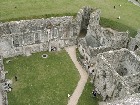The Normans
The Norman Invasion and Conquest of England
In the year 1066, the Saxon-Dane rulers of England were overthrown and replaced by new invaders.... The Normans
By the end of the year, the old king was gone and the fate of the country was changed for ever.
Who were the Normans?
A short history of the Norman peoples
 A common misconception today is that the Normans were "French." Strictly speaking this is not true although it is a widely held belief and, like most beliefs, has some basis in fact.
A common misconception today is that the Normans were "French." Strictly speaking this is not true although it is a widely held belief and, like most beliefs, has some basis in fact.
 Towards the end of the ninth century, the Viking raiders from Northern Europe (commonly known as Norsemen) were regularly foraging (raiding and trading) along the coast line of the Frankish kingdoms. During these raids, the Vikings got more and more bold - even going as far as sailing up the Seine and sacking Paris. Initially the raiders would set off from their home villages in Scandinavia and return a few weeks later with any plunder they had gathered, however as the raids continued the Norsemen started establishing raiding bases away from home. It was during this time that England was invaded by the "Grand Army" (more detail in the Vikings Section). These bases were often in very good farmland and quickly grew rich with the spoils of war, and as a result of this quickly grew in size.
Towards the end of the ninth century, the Viking raiders from Northern Europe (commonly known as Norsemen) were regularly foraging (raiding and trading) along the coast line of the Frankish kingdoms. During these raids, the Vikings got more and more bold - even going as far as sailing up the Seine and sacking Paris. Initially the raiders would set off from their home villages in Scandinavia and return a few weeks later with any plunder they had gathered, however as the raids continued the Norsemen started establishing raiding bases away from home. It was during this time that England was invaded by the "Grand Army" (more detail in the Vikings Section). These bases were often in very good farmland and quickly grew rich with the spoils of war, and as a result of this quickly grew in size.
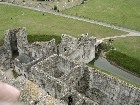 In AD. 911, the Frankish King Charles (the Simple), in an effort to reduce the raids and destruction offered a large amount of land in northern France to a band of Vikings led by Rollo in return for token obedience to the Frankish crown. During the years of "Duke" Rollo's reign, the local term for the "Norsemen" slowly contracted to "Norman" and this pretty much stuck for the rest of time.
In AD. 911, the Frankish King Charles (the Simple), in an effort to reduce the raids and destruction offered a large amount of land in northern France to a band of Vikings led by Rollo in return for token obedience to the Frankish crown. During the years of "Duke" Rollo's reign, the local term for the "Norsemen" slowly contracted to "Norman" and this pretty much stuck for the rest of time.
As befitting the descendants of excellent sea farers, the Normans traded with most of the kingdoms and Empires. They provided soldiers to act as a papal guard and not long after the conquest of the Angle's lands (England) they turned their attention to other places. The Normans raided Italy, and were a driving force behind the Crusades.
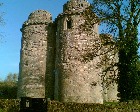 From the British point of view, the main identifiers of the Norman invaders were the language they spoke (a variant of Frankish - French) and their tendency to build castles everywhere. Prior to the Norman occupation, both the Anglo-Saxons and the Celtic Britons before them had lived in smallish communities built on hill tops. These Hill Forts were the primary means of defence and provided a community central point for refuge etc.
From the British point of view, the main identifiers of the Norman invaders were the language they spoke (a variant of Frankish - French) and their tendency to build castles everywhere. Prior to the Norman occupation, both the Anglo-Saxons and the Celtic Britons before them had lived in smallish communities built on hill tops. These Hill Forts were the primary means of defence and provided a community central point for refuge etc.
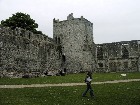 Following the Invasion of AD1066, one of the first things William I wanted to do was to establish Norman control. This was, in part, enforced by the building of Motte and Bailey castles over the land where the Norman Knights could have a base to subjugate the surrounding lands. To ease the building, these were often on the site of Hill Forts, and equally often these hill forts had been removed from the local Celtic/Saxon nobility not to long in the past. Building on hill forts is one of the reasons why so many Norman castles (especially the early ones) are of the famous motte and bailey design. This design is easy to implement over the site of a previous hill fort. You can read more on Motte and Bailey Castles in the Etrusia Article. On occasion, the Norman buildings were inside even older structures - such as the Norman Castle inside the Roman Fort at Portchester (Shown).
Following the Invasion of AD1066, one of the first things William I wanted to do was to establish Norman control. This was, in part, enforced by the building of Motte and Bailey castles over the land where the Norman Knights could have a base to subjugate the surrounding lands. To ease the building, these were often on the site of Hill Forts, and equally often these hill forts had been removed from the local Celtic/Saxon nobility not to long in the past. Building on hill forts is one of the reasons why so many Norman castles (especially the early ones) are of the famous motte and bailey design. This design is easy to implement over the site of a previous hill fort. You can read more on Motte and Bailey Castles in the Etrusia Article. On occasion, the Norman buildings were inside even older structures - such as the Norman Castle inside the Roman Fort at Portchester (Shown).
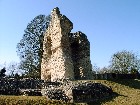 Another common trait of the Normans, was their love of Hunting. In addition to the construction of new forest blocks across the Country, the Normans established lots of new laws. These were all very unpopular with the local British - often they were now unable to hunt or farm on their own land. While the Norman hunting may have left some gorgeous forestry blocks, and been responsible for the importation of new species, it certainly was not started from ecological grounds. Another side effect of this hunting fanaticism, was the construction of hundreds of hunting lodges around the country. These mini-castles, like Luggershall (pictured) were used by the Knights and Kings as places to stay and feast while they were out hunting (which was a lot of the time). Although they were never used as fortified bases in the way the Castles were, the hunting lodges were remarkably well built. A sign of how cheap labour and materials were to the Norman overlords.
Another common trait of the Normans, was their love of Hunting. In addition to the construction of new forest blocks across the Country, the Normans established lots of new laws. These were all very unpopular with the local British - often they were now unable to hunt or farm on their own land. While the Norman hunting may have left some gorgeous forestry blocks, and been responsible for the importation of new species, it certainly was not started from ecological grounds. Another side effect of this hunting fanaticism, was the construction of hundreds of hunting lodges around the country. These mini-castles, like Luggershall (pictured) were used by the Knights and Kings as places to stay and feast while they were out hunting (which was a lot of the time). Although they were never used as fortified bases in the way the Castles were, the hunting lodges were remarkably well built. A sign of how cheap labour and materials were to the Norman overlords.
